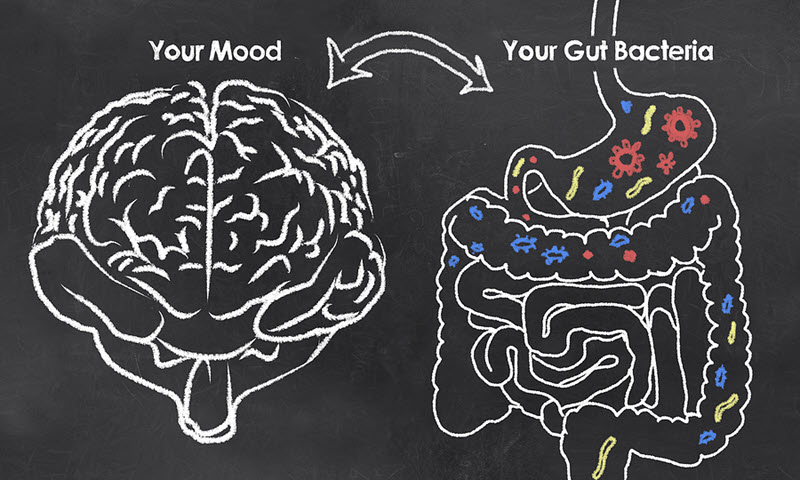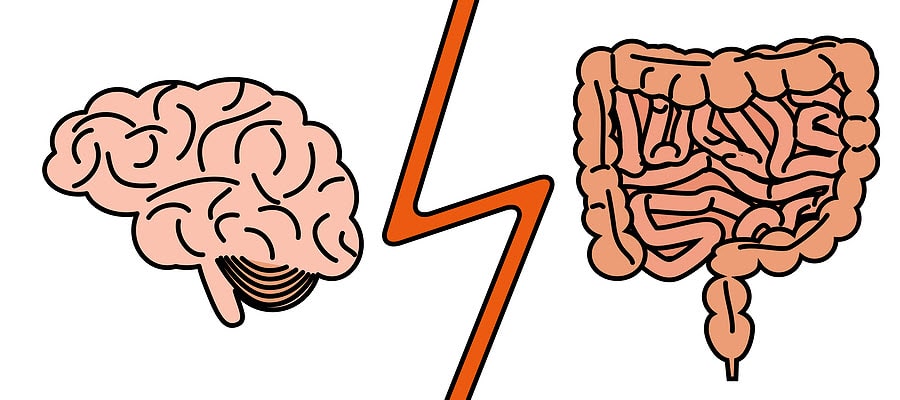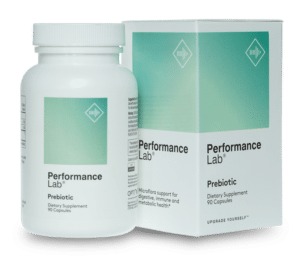Table of Contents
 Ever wonder why you get butterflies in your stomach when you’re nervous? Or cramps in your gut when struggling with some monumental life decision?
Ever wonder why you get butterflies in your stomach when you’re nervous? Or cramps in your gut when struggling with some monumental life decision?
You experience these sensations because of what’s happening in your gut. And the connection between your brain and your gut.
More and more people are becoming aware of the health benefits that come from using the best prebiotics and probiotics.
Which should come as no surprise. Especially once you realize that 90% of you is composed of microbiota cells with 10 million microbiota genes. Harboring over 100 trillion good gut bacteria.[i]
Definition: ‘microbiota’ is the actual bacteria and ‘microbiome’ is the bacteria and their genes.
Your microbiome has 10-times more cells than regular human body cells. 150-times more than the number of human genes. 1,000 microbiota species and over 7,000 strains.[ii]
Your intestines are home to about 1 kg (2.2 lbs.) of bacteria, viruses, protozoans, fungi, and archaea (collectively known as your microbiome).[iii]
Your gut microbiota is linked to your brain through a system that involves your vagus nerve, your immune system, and various neurotransmitters.[iv]
And decades of research have found that of 1,000 species of bacteria residing in your gut, the primary species of beneficial bacteria are the bacterial groups Bifidobacterium and Lactobacillus.[v]
See my #1 Rated Prebiotic Supplement Here
Prebiotics and probiotics: which is best?
One option for enjoying the health benefits that help support your microbiome is to choose a probiotic supplement. Ideally, selecting a supplement containing the exact Bifidobacterium and Lactobacillus strains your body needs.
The challenge however in selecting the right probiotic supplement is by identifying the few strains of bacteria in your gut that require support.
So, even if you guessed correctly, probiotic supplements are degraded by cold, heat, light, and time. And then once you swallow the capsule, must survive the acidic gastric environment in your digestive system if they’re to reach your small intestine so you experience the benefits.[vi]
Another problem is trusting probiotic supplement labels. Which typically state the number of colony forming units (CFU) in each capsule. In other words, the number of live bacteria in each capsule.
CFU ranges from millions to 50 billion or more per serving. The thing is manufacturers are not required to list how many ‘live’ probiotics are included in the total CFU. Half the bacteria could be dead. There’s no way to tell for sure.
And if you’ve guessed incorrectly by sending a mix of billions of probiotic bacteria of different strains into your system, you can experience constipation, bloating, gas, or an upset stomach.
A better idea is to help the native Bifidobacterium and Lactobacillus already in your gut. And support them with quality prebiotic supplements. Support the built-in intelligence your microbiome has had from the beginning.
Prebiotics are available in food as soluble fiber. Or as prebiotic supplements if you don’t get enough fiber in your diet.
 What are prebiotic foods?
What are prebiotic foods?
Foods with prebiotics contain soluble fiber that pass through your upper intestinal tract undigested.
As prebiotic fiber passes through your small intestine to your colon, they’re fermented by your existing gut bacteria.
The beneficial bacteria in your gut feed on this fermented prebiotic fiber. Helping these healthy bacteria produce short-chain fatty acids like butyrate, acetate, and propionate.[vii]
Prebiotics like inulin and oligofructose occur naturally in foods such as leeks, asparagus, chicory root, Jerusalem artichokes, garlic, onions, wheat, oats, and soybeans.[viii]
Is apple cider vinegar a prebiotic?
The word “vinegar” comes from the French vin aigre which means sour wine.
The sourness of vinegar comes from acetic acid.
When making apple cider vinegar, yeast digests the sugars in apples and converts them into alcohol. A bacteria called acetobacter turns the alcohol into acetic acid.
This fermentation process produces the “mother” which are the strands you see floating around in the bottom of apple cider vinegar. The mother is a combination of yeast and bacteria.
The mother in apple cider vinegar is a probiotic supplement. Not a prebiotic supplement.[ix]
What are prebiotics used for?
Prebiotics are non-digestible soluble fiber that probiotics (your healthy gut bacteria) can use for food. The best prebiotics are found in foods and supplements.
But prebiotics do more than only benefiting gut health issues like irritable bowel syndrome (IBS), Inflammatory Bowel Disease (IBD), Crohn’s disease, and colon cancer.
The best prebiotics also help boost cognition, learning, memory, and mood.
Prebiotics help support your immune system, heart health, reduce LDL (bad) cholesterol, improve calcium absorption, and skin health.[x]
By boosting soluble fiber intake and supporting your microbiome, prebiotic supplements help provide gut health benefits that no other supplement can.
Prebiotics and digestive supplements
Prebiotic supplements can support gut and digestive health. As well as protect against Irritable Bowel Syndrome (IBS), Crohn’s Disease, and colorectal cancer[xi].
A randomized, double-blind trial was conducted with 105 patients suffering from functional bowel disorder (FBD).
Half of the group was given 5 g of short-chain fructo-oligosaccharides (sc-FOS) per day for 6-weeks. The other half received a placebo.
By Day 43, digestive tract disorders decreased by 43.6% in the sc-FOS group compared to only a 13.8% decrease in the placebo group.
The researchers concluded that regular consumption of sc-FOS may improve digestive tract comfort in those not undergoing medical treatment.[xii]
Another study at Imperial College Healthcare in London investigated the efficacy of using prebiotics to improve the symptoms of people dealing with Irritable Bowel Syndrome (IBS).
44 IBS patients were given either 3.5 g per day of a prebiotic, 7 g per day of a prebiotic, or 7 g per day of a placebo.
IBS symptoms were monitored weekly for 12-weeks and scored according to a 7-point Likert scale. Changes in fecal microflora, stool frequency and form, anxiety and depression scores were also monitored.
Patients using both 3.5 g and 7 g per day of prebiotic supplements showed a significant improvement in fecal bifidobacteria, stool consistency, less flatulence and bloating, and improved anxiety and depression scores. The placebo had no effect.
The researchers concluded that the prebiotic intake (trans-galacto-oligosaccharide) was highly effective in alleviating IBS symptoms. And the findings suggest that the prebiotic fibers has potential as a therapeutic agent in IBS.[xiii]
Another study was conducted to assess the effects of a prebiotic in 10 patients with Crohn’s Disease.
Patients with active Crohn’s Disease received 15 g of a Fructo-oligosaccharides (FOS) prebiotic for 3 weeks. Disease activity was measured using the Harvey Bradshaw index.
FOS significantly reduced Crohn’s symptoms. The patients showed an increase in fecal bifidobacteria concentration, and an increase in dendritic cells.
The researchers concluded that the prebiotic FOS decreased Crohn’s Disease activity and warranted further investigation.[xiv]
 Prebiotics and immune system health
Prebiotics and immune system health
Everything you eat and drink ends up passing through your digestive system. Both the good and the bad. Your gut health is your first line of defense against bad bacteria.
70% of your entire immune system resides in your gut.[xv]
Bifidobacteria are the dominant species of beneficial bacteria in your gut.[xvi] And are a critical species providing protection for a healthy gut microbiome.
Bifidobacteria help colonize the protective mucus layer of your gastrointestinal tract. Preventing bad bacteria from crossing the barrier into your bloodstream.[xvii]
Several studies show the potential of bifidobacteria to prevent and/or treat colorectal cancer. And have demonstrated protection against carcinogens, protection against DNA damage from carcinogens, and inhibit cancer growth.
This species of good bacteria is also used to treat various gastrointestinal disorders. Including diarrhea,[xviii] colitis, and irritable bowel syndrome (IBS).[xix]
The prebiotic fructo-oligosaccharides (FOS) have been shown to increase bifidobacteria numbers.[xx] And decrease the numbers of bad bacteria including E. coli and enterococci.
In one study, 8 g per day of the patented oligofructose prebiotic supplement Orafti® Synergy1 for 8 weeks improved the immune response of an influenza vaccine.[xxi]
A mixture of the prebiotics oligofructose and inulin can improve antibody response supporting viral vaccines for things like influenza and measles.[xxii]
Studies have also shown the improvement of antibody response of an influenza vaccine following Fructo-oligosaccharides (FOS) supplementation. And the side effects from the influenza vaccine were reduced.[xxiii]
What is the best prebiotic for weight loss?
For millennia, people have noted that high-fiber foods were more filling than low-fiber foods. And clinicals trials over 50 years ago were using prebiotic supplements as an aid to weight loss.[xxiv]
Research at leading universities show adequate daily intake of dietary fiber and prebiotics significantly enhances weight loss.[xxv]
In fact, several large clinical studies demonstrate that prebiotic consumption reduces the risk of gaining weight or developing obesity by approximately 30%.[xxvi]
Studies which include people from across ethnic and racial groups show that those who have higher levels of fiber consumption maintain less weight than those with the lowest fiber intakes.
One study at the Université Catholique de Louvain in Brussels demonstrated young people supplementing with the prebiotic dietary fiber oligofructose significantly increased the feelings of satiety and reducing hunger between meals.[xxvii]
Another study at the University of Calgary in Canada showed that overweight children supplementing with inulin FOS were able to lose weight.
The researchers concluded that obese children who supplemented with inulin FOS significantly reduced body weight, percent body fat, percent trunk fat, and reduced inflammatory cytokines interleukin 6 (IL-6).[xxviii]
Prebiotics and insulin resistance
Glucagon-like peptide-1 (GLP-1) is a peptide hormone in your gut which inhibits food intake, is involved in weight loss, stimulates insulin secretion, and reduces blood sugar.[xxix]
Reduced levels of GLP-1 can result in insulin resistance and prevent weight loss.[xxx]
Prebiotic supplementation increases levels of GLP-1 in your gut. Which results in changes in appetite sensation, helps control heat, and reduces insulin resistance.[xxxi]
 What is the best way to take prebiotics?
What is the best way to take prebiotics?
One of the most effective and proven soluble-fiber prebiotics is sourced from chicory root. And is called Inulin FOS (FructoOligoSaccharides).
Inulin is a long-chain storage carbohydrate derived by water extraction from chicory root. The short-chain Oligofructose or Fructose-Oligosaccharide (FOS) is derived from inulin with an enzyme that also naturally exists in chicory root.
I use and recommend the patented Orafti® Synergy1 because it provides Inulin and FructoOligoSaccharides which passes through your system undigested to your large intestine.
Once there, Inulin and FOS are fermented in your gut by bacteria like bifidobacteria. Which leads to an increase of bifidobacteria.
This fermentation also produces short-chain fatty acids (SCFAs) including acetate, propionate, and butyrate.[xxxii]
This prebiotic supplement is available in capsule form made by Performance Lab®. And is called Click for Performance Lab® Prebiotic
The prebiotic fiber Orafti® Synergy1 is also used as a functional fiber in various food products. It has a mild, sweet flavor that easily mixes with foods like ice cream, baby food, cereals, chocolates, and baked goods.
You can take Performance Lab® Prebiotic right along with your other supplements with a glass of water.
And because this organic prebiotic fiber blend is sweet with no aftertaste, you can open the capsules and mix them with your favorite drink.
Nootropics Expert Recommendation
 The best prebiotic supplement using the patented Orafti® Synergy1 is Performance Lab® Prebiotic.
The best prebiotic supplement using the patented Orafti® Synergy1 is Performance Lab® Prebiotic.
Performance Lab® Prebiotic is the cleanest, premium quality Orafti® Synergy1 prebiotic supplement available today.
This prebiotic provides 2 grams of Orafti® Synergy1 per dose in 3 vegan-friendly capsules.
It comes in NutriCaps® capsules made from fermented tapioca also infused with prebiotics.
No “other ingredients” except organic rice powder used as flow agent during encapsulation.
I use and highly recommend this premium prebiotic supplement to help grow beneficial gut bacteria.







Join The Discussion - 14 comments
Ada
June 12, 2025
Hi David, my mom is diabetic, will she be able to use, as you stated is from rice, rice has starch? please let me know, thank you
David Tomen
June 14, 2025
Ada, Performance Lab Prebiotic is NOT made from “rice”. It is concentrated and patented FructoOligoSaccharides made from from Chicory Root. They use a tiny bit of NuFlow rice concentrate which is a natural method of preventing powder from clogging up encapsulations machinery. This is far safer than using magnesium stearate or some other toxic additive to do this job. This supplement will benefit anyone including diabetics who need gut support.
José
May 1, 2023
Hi David! In my country it’s not easy to access Performance Lab. But I did found a German brand called Beneo. And bought from them their Orafti GR prebiotic in powder form. But with no “Synergy” . Would you recommend this one as well?
David Tomen
May 1, 2023
Jose, if it contains the branded form Orafti® Synergy1 it should be a good prebiotic. It’s the one I use from Performance Lab and it works great!
Jose
June 12, 2023
Thanks for your answer. But I’m still wondering if there is any difference between the Orafti®GR and the Orafti®Synergy1. Since the first one is the only one sold in my country.
David Tomen
June 16, 2023
Jose, they appear to be the same ingredient according the supplement facts label.
Bruce
June 29, 2022
Hello David, I am a client of Performance lab thanks to you but I have some doubts that I would really appreciate if you could help me,
I prefer to open the capsules of Performance Lab® Prebiotic and mix them with coffee and coconut oil, it is my favorite way to take it, But I am afraid I am not taking advantage of its benefits,
according to your experience is it possible that it will reach my large intestine even if I open the capsule?
Lastly, I would like to know how many times a week you consume probiotics like this? Thank you
NewRhythm Probiotics 50 Billion CFU
David Tomen
July 1, 2022
Bruce, the prebiotic is soluble fiber. So it’ll make it to the part of your intestine where it’s needed.
The probiotic dosage depends entirely on why you are using it. If you are on my list you may recall that probiotic was dosed at 900 CUFU per day and not 50 CFU which this supplement is. If you were using the dose recommended by the manufacturer it would be daily.
Sandra
May 25, 2022
Hi David! I bought 3g per dose of FOS from Jarrow formulas. What do you think? I want to quit probiotics.
David Tomen
May 25, 2022
Sandra, since I began using the Performance Lab Prebiotic which contains the same patented ingredient as the Jarrow supplement I’ve stopped using probiotics. Because I have found the prebiotic to be far more effective.
Carlos
May 24, 2022
Hi David how are you?,
I just wanted to know if this brand is a good option to get Inulin FOS prebiotics? (I can’t get Performance Lab® Prebiotic due to customs problems in my country)
Thank you
Jarrow Formulas Prebiotic Inulin
David Tomen
May 24, 2022
Carlos, that is an alternative because I believe they use the same patented inulin-FOS ingredient.
Malik
October 4, 2021
Hi David! I heard sodium butrayte enhances fear extinction? What brand do recommend for sodium butrayte. Thanks
David Tomen
October 4, 2021
Mailk, Sodium butyrate is naturally produced in your gut from soluble fiber. I have not done any research on this compound and it is unlikely that I will because of lack of clinical studies on how it affects the human brain. So cannot help you with a brand. Best to use my tips on choosing a supplement from this guide: https://nootropicsexpert.com/7-tips-for-choosing-the-highest-quality-nootropic-supplements/